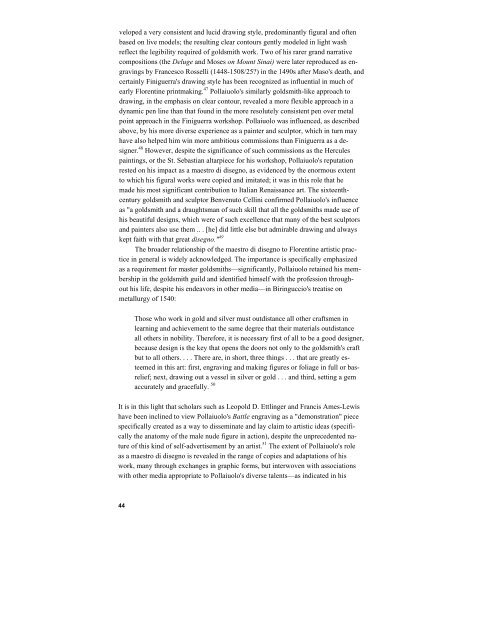Battle of the Nudes
Battle of the Nudes
Battle of the Nudes
Create successful ePaper yourself
Turn your PDF publications into a flip-book with our unique Google optimized e-Paper software.
veloped a very consistent and lucid drawing style, predominantly figural and <strong>of</strong>ten<br />
based on live models; <strong>the</strong> resulting clear contours gently modeled in light wash<br />
reflect <strong>the</strong> legibility required <strong>of</strong> goldsmith work. Two <strong>of</strong> his rarer grand narrative<br />
compositions (<strong>the</strong> Deluge and Moses on Mount Sinai) were later reproduced as en-<br />
gravings by Francesco Rosselli (1448-1508/25?) in <strong>the</strong> 1490s after Maso's death, and<br />
certainly Finiguerra's drawing style has been recognized as influential in much <strong>of</strong><br />
early Florentine printmaking. 47 Pollaiuolo's similarly goldsmith-like approach to<br />
drawing, in <strong>the</strong> emphasis on clear contour, revealed a more flexible approach in a<br />
dynamic pen line than that found in <strong>the</strong> more resolutely consistent pen over metal<br />
point approach in <strong>the</strong> Finiguerra workshop. Pollaiuolo was influenced, as described<br />
above, by his more diverse experience as a painter and sculptor, which in turn may<br />
have also helped him win more ambitious commissions than Finiguerra as a de-<br />
signer. 48 However, despite <strong>the</strong> significance <strong>of</strong> such commissions as <strong>the</strong> Hercules<br />
paintings, or <strong>the</strong> St. Sebastian altarpiece for his workshop, Pollaiuolo's reputation<br />
rested on his impact as a maestro di disegno, as evidenced by <strong>the</strong> enormous extent<br />
to which his figural works were copied and imitated; it was in this role that he<br />
made his most significant contribution to Italian Renaissance art. The sixteenth-<br />
century goldsmith and sculptor Benvenuto Cellini confirmed Pollaiuolo's influence<br />
as "a goldsmith and a draughtsman <strong>of</strong> such skill that all <strong>the</strong> goldsmiths made use <strong>of</strong><br />
his beautiful designs, which were <strong>of</strong> such excellence that many <strong>of</strong> <strong>the</strong> best sculptors<br />
and painters also use <strong>the</strong>m .. . [he] did little else but admirable drawing and always<br />
kept faith with that great disegno." 49<br />
The broader relationship <strong>of</strong> <strong>the</strong> maestro di disegno to Florentine artistic prac-<br />
tice in general is widely acknowledged. The importance is specifically emphasized<br />
as a requirement for master goldsmiths—significantly, Pollaiuolo retained his mem-<br />
bership in <strong>the</strong> goldsmith guild and identified himself with <strong>the</strong> pr<strong>of</strong>ession through-<br />
out his life, despite his endeavors in o<strong>the</strong>r media—in Biringuccio's treatise on<br />
metallurgy <strong>of</strong> 1540:<br />
Those who work in gold and silver must outdistance all o<strong>the</strong>r craftsmen in<br />
learning and achievement to <strong>the</strong> same degree that <strong>the</strong>ir materials outdistance<br />
all o<strong>the</strong>rs in nobility. Therefore, it is necessary first <strong>of</strong> all to be a good designer,<br />
because design is <strong>the</strong> key that opens <strong>the</strong> doors not only to <strong>the</strong> goldsmith's craft<br />
but to all o<strong>the</strong>rs. . . . There are, in short, three things . . . that are greatly es-<br />
teemed in this art: first, engraving and making figures or foliage in full or bas-<br />
relief; next, drawing out a vessel in silver or gold . . . and third, setting a gem<br />
accurately and gracefully. 50<br />
It is in this light that scholars such as Leopold D. Ettlinger and Francis Ames-Lewis<br />
have been inclined to view Pollaiuolo's <strong>Battle</strong> engraving as a "demonstration" piece<br />
specifically created as a way to disseminate and lay claim to artistic ideas (specifi-<br />
cally <strong>the</strong> anatomy <strong>of</strong> <strong>the</strong> male nude figure in action), despite <strong>the</strong> unprecedented na-<br />
ture <strong>of</strong> this kind <strong>of</strong> self-advertisement by an artist. 51 The extent <strong>of</strong> Pollaiuolo's role<br />
as a maestro di disegno is revealed in <strong>the</strong> range <strong>of</strong> copies and adaptations <strong>of</strong> his<br />
work, many through exchanges in graphic forms, but interwoven with associations<br />
with o<strong>the</strong>r media appropriate to Pollaiuolo's diverse talents—as indicated in his<br />
44
















